Do Ecological Restoration Projects Undermine Economic Performance? A Spatially Explicit Empirical Study in Loess Plateau, China
Abstract
1. Introduction
2. Study Area
3. Materials and Methods
3.1. Data Sources
3.2. Estimation of Soil Retention Service
3.3. The Spatialization of Gross Domestic Product
3.4. Exploration of the Relationship between Soil Retention Service and Gross Domestic Product
4. Results
4.1. Spatial and Temporal Variation Characteristics of Soil Retention Service
4.2. Spatial and Temporal Characteristics of Economic Development
4.3. The Relationship between Soil Retention Service and Economic Development
5. Discussion
6. Conclusions
Author Contributions
Funding
Data Availability Statement
Acknowledgments
Conflicts of Interest
Appendix A
| Land Use Types | 1980 | 2000 | 2005 | 2010 | 2015 | 2018 |
|---|---|---|---|---|---|---|
| Cultivated land | 0.0985 | 0.0879 | 0.0747 | 0.0791 | 0.0871 | 0.0903 |
| Woodland | 0.0451 | 0.0384 | 0.0360 | 0.0345 | 0.0362 | 0.0396 |
| Grassland | 0.1467 | 0.1343 | 0.1200 | 0.1230 | 0.1171 | 0.1078 |
| Waters | 0.1556 | 0.1313 | 0.1166 | 0.1533 | 0.1398 | 0.1294 |
| Construction land | 0.0839 | 0.0769 | 0.0721 | 0.0852 | 0.1028 | 0.1092 |
| Unutilized land | 0.3120 | 0.2825 | 0.2628 | 0.2801 | 0.2855 | 0.2122 |
Appendix B
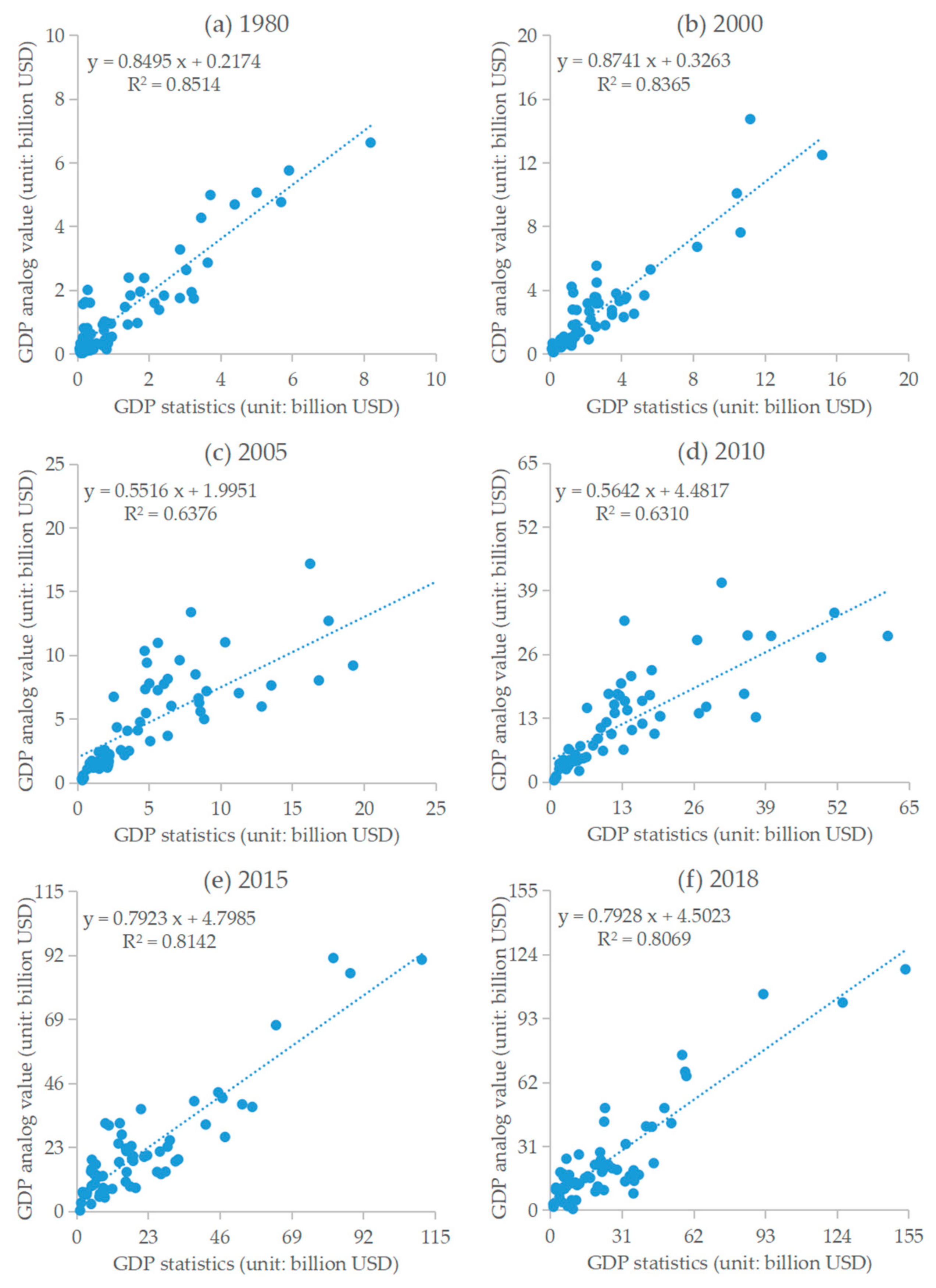
References
- Costanza, R.; de Groot, R.; Braat, L.; Kubiszewski, I.; Fioramonti, L.; Sutton, P.; Farber, S.; Grasso, M. Twenty years of ecosystem services: How far have we come and how far do we still need to go? Ecosyst. Serv. 2017, 28 Pt A, 1–16. [Google Scholar] [CrossRef]
- Daily, G.; Myers, J.P.; Reichert, J.; Postel, S. Nature’s Services: Societal Dependence on Natural Ecosystems; Island Press: Washington, DC, USA, 1997. [Google Scholar]
- Newbold, T.; Hudson, L.N.; Arnell, A.P.; Contu, S.; De Palma, A.; Ferrier, S.; Hill, S.L.L.; Hoskins, A.J.; Lysenko, I.; Phillips, H.R.P.; et al. Has land use pushed terrestrial biodiversity beyond the planetary boundary? A global assessment. Science 2016, 353, 288–291. [Google Scholar] [CrossRef] [PubMed]
- Johnson, C.N.; Balmford, A.; Brook, B.W.; Buettel, J.C.; Galetti, M.; Lei, G.C.; Wilmshurst, J.M. Biodiversity losses and conservation responses in the Anthropocene. Science 2017, 356, 270–274. [Google Scholar] [CrossRef] [PubMed]
- Foley, J.A.; DeFries, R.; Asner, G.P.; Barford, C.; Bonan, G.; Carpenter, S.R.; Chapin, F.S.; Coe, M.T.; Daily, G.C.; Gibbs, H.K.; et al. Global consequences of land use. Science 2005, 309, 570–574. [Google Scholar] [CrossRef] [PubMed]
- Li, S.; Zhang, H.; Zhou, X.; Yu, H.; Li, W. Enhancing protected areas for biodiversity and ecosystem services in the Qinghai–Tibet Plateau. Ecosyst. Serv. 2020, 43, 101090. [Google Scholar] [CrossRef]
- Millennium, E.A. Ecosystems and Human Well-Being: Synthesis; World Resources Institute: Washington, DC, USA, 2005. [Google Scholar]
- Bongaarts, J. Summary for policymakers of the global assessment report on biodiversity and ecosystem services of the Intergovernmental Science-Policy Platform on Biodiversity and Ecosystem Services. Popul. Dev. Rev. 2019, 45, 680–681. [Google Scholar] [CrossRef]
- United Nations. Transforming Our World: The 2030 Agenda for Sustainable Development. 2015. Available online: https://sustainabledevelopment.un.org/post2015/transformingourworld/publication (accessed on 15 October 2015).
- Keesstra, S.; Mol, G.; de Leeuw, J.; Okx, J.; Molenaar, C.; de Cleen, M.; Visser, S. Soil-Related Sustainable Development Goals: Four Concepts to Make Land Degradation Neutrality and Restoration Work. Land 2018, 7, 133. [Google Scholar] [CrossRef]
- Sachs, J.D.; Schmidt-Traub, G.; Mazzucato, M.; Messner, D.; Nakicenovic, N.; Rockstrom, J. Six Transformations to achieve the Sustainable Development Goals. Nat. Sustain. 2019, 2, 805–814. [Google Scholar] [CrossRef]
- Fischer, J.; Riechers, M.; Loos, J.; Martin-Lopez, B.; Temperton, V.M. Making the UN Decade on Ecosystem Restoration a Social-Ecological Endeavour. Trends Ecol. Evol. 2021, 36, 20–28. [Google Scholar] [CrossRef]
- Morita, K.; Okitasari, M.; Masuda, H. Analysis of national and local governance systems to achieve the sustainable development goals: Case studies of Japan and Indonesia. Sustain. Sci. 2020, 15, 179–202. [Google Scholar] [CrossRef]
- Yu, S.M.; Sial, M.S.; Tran, D.K.; Badulescu, A.; Thu, P.A.; Sehleanu, M. Adoption and Implementation of Sustainable Development Goals (SDGs) in China-Agenda 2030. Sustainability 2020, 12, 6288. [Google Scholar] [CrossRef]
- Pashkevich, M.D.; d’Albertas, F.; Aryawan, A.A.K.; Buchori, D.; Caliman, J.-P.; Chaves, A.D.G.; Hidayat, P.; Kreft, H.; Naim, M.; Razafimahatratra, A.; et al. Nine actions to successfully restore tropical agroecosystems. Trends Ecol. Evol. 2022, 37, 963–975. [Google Scholar] [CrossRef] [PubMed]
- Feng, X.M.; Fu, B.J.; Piao, S.; Wang, S.H.; Ciais, P.; Zeng, Z.Z.; Lu, Y.H.; Zeng, Y.; Li, Y.; Jiang, X.H.; et al. Revegetation in China’s Loess Plateau is approaching sustainable water resource limits. Nat. Clim. Chang. 2016, 6, 1019–1022. [Google Scholar] [CrossRef]
- Deng, L.; Liu, G.B.; Shangguan, Z.P. Land-use conversion and changing soil carbon stocks in China’s ‘Grain-for-Green’ Program: A synthesis. Glob. Chang. Biol. 2014, 20, 3544–3556. [Google Scholar] [CrossRef] [PubMed]
- Cao, Z.; Li, Y.R.; Liu, Y.S.; Chen, Y.F.; Wang, Y.S. When and where did the Loess Plateau turn “green”? Analysis of the tendency and breakpoints of the normalized difference vegetation index. Land Degrad. Dev. 2018, 29, 162–175. [Google Scholar] [CrossRef]
- Lu, N.; Fu, B.J.; Stafford-Smith, M.; Maestre, F.T.; Cheng, L.H. Breaking the land degradation-poverty nexus in drylands. Sci. Bull. 2022, 67, 2508–2512. [Google Scholar] [CrossRef]
- Mehrabi, Z.; Ellis, E.C.; Ramankutty, N. The challenge of feeding the world while conserving half the planet. Nat. Sustain. 2018, 1, 409–412. [Google Scholar] [CrossRef]
- Xing, L.; Xue, M.G.; Hu, M.S. Dynamic simulation and assessment of the coupling coordination degree of the economy-resource-environment system: Case of Wuhan City in China. J. Environ. Manag. 2019, 230, 474–487. [Google Scholar] [CrossRef]
- Schaltegger, S.; Synnestvedt, T. The link between ‘green’ and economic success: Environmental management as the crucial trigger between environmental and economic performance. J. Environ. Manag. 2002, 65, 339–346. [Google Scholar] [CrossRef]
- Wagner, M. How to reconcile environmental and economic performance to improve corporate sustainability: Corporate environmental strategies in the European paper industry. J. Environ. Manag. 2005, 76, 105–118. [Google Scholar] [CrossRef]
- Liu, J.G.; Hull, V.; Batistella, M.; DeFries, R.; Dietz, T.; Fu, F.; Hertel, T.W.; Izaurralde, R.C.; Lambin, E.F.; Li, S.X.; et al. Framing Sustainability in a Telecoupled World. Ecol. Soc. 2013, 18, 26. [Google Scholar] [CrossRef]
- Tamazian, A.; Chousa, J.P.; Vadlamannati, K.C. Does higher economic and financial development lead to environmental degradation: Evidence from BRIC countries. Energy Policy 2009, 37, 246–253. [Google Scholar] [CrossRef]
- Dinda, S. Environmental Kuznets Curve hypothesis: A survey. Ecol. Econ. 2004, 49, 431–455. [Google Scholar] [CrossRef]
- Leal, P.H.; Marques, A.C. The evolution of the environmental Kuznets curve hypothesis assessment: A literature review under a critical analysis perspective. Heliyon 2022, 8, e11521. [Google Scholar] [CrossRef] [PubMed]
- Hsiao, C.-M. Economic Growth, CO2 Emissions Quota and Optimal Allocation under Uncertainty. Sustainability 2022, 14, 8706. [Google Scholar] [CrossRef]
- Apergis, N.; Ozturk, I. Testing Environmental Kuznets Curve hypothesis in Asian countries. Ecol. Indic. 2015, 52, 16–22. [Google Scholar] [CrossRef]
- Venter, O.; Sanderson, E.W.; Magrach, A.; Allan, J.R.; Beher, J.; Jones, K.R.; Possingham, H.P.; Laurance, W.F.; Wood, P.; Fekete, B.M.; et al. Sixteen years of change in the global terrestrial human footprint and implications for biodiversity conservation. Nat. Commun. 2016, 7, 12558. [Google Scholar] [CrossRef] [PubMed]
- Konan, D.E. Limits to growth: Tourism and regional labor migration. Econ. Model. 2011, 28, 473–481. [Google Scholar] [CrossRef]
- Hatfield-Dodds, S.; Schandl, H.; Adams, P.D.; Baynes, T.M.; Brinsmead, T.S.; Bryan, B.A.; Chiew, F.H.S.; Graham, P.W.; Grundy, M.; Harwood, T.; et al. Australia is ‘free to choose’ economic growth and falling environmental pressures. Nature 2015, 527, 49–53. [Google Scholar] [CrossRef]
- Li, S.; Liu, X.; Paudel, B.; Xu, F.; Deng, Q. Stable sediment retention and rapid economic growth occurred together from the end of the 1970s to 2015 in the Three Gorges Reservoir area. Land Degrad. Dev. 2021, 32, 3653–3665. [Google Scholar] [CrossRef]
- Hartmann, J.; Preisendörfer, P. The relationship between ecology and economy in German public opinion, 1984–2019. Environ. Polit. 2023, 1–20. [Google Scholar] [CrossRef]
- Acuna, V.; Diez, J.R.; Flores, L.; Meleason, M.; Elosegi, A. Does it make economic sense to restore rivers for their ecosystem services? J. Appl. Ecol. 2013, 50, 988–997. [Google Scholar] [CrossRef]
- Fang, C.L.; Liu, H.M.; Li, G.D. International progress and evaluation on interactive coupling effects between urbanization and the eco-environment. J. Geogr. Sci. 2016, 26, 1081–1116. [Google Scholar] [CrossRef]
- Liu, J.; Li, S.; Ouyang, Z.; Tam, C.; Chen, X. Ecological and socioeconomic effects of China’s policies for ecosystem services. Proc. Natl. Acad. Sci. USA 2008, 105, 9477–9482. [Google Scholar] [CrossRef] [PubMed]
- Folke, C. Resilience: The emergence of a perspective for social-ecological systems analyses. Glob. Environ. Chang.-Hum. Policy Dimens. 2006, 16, 253–267. [Google Scholar] [CrossRef]
- Ostrom, E. A General Framework for Analyzing Sustainability of Social-Ecological Systems. Science 2009, 325, 419–422. [Google Scholar] [CrossRef]
- Liu, H.M.; Fang, C.L.; Fang, K. Coupled Human and Natural Cube: A novel framework for analyzing the multiple interactions between humans and nature. J. Geogr. Sci. 2020, 30, 355–377. [Google Scholar] [CrossRef]
- Ren, M.E. Sediment discharge of the Yellow River, China: Past, present and future—A synthesis. Acta Oceanol. Sin. 2015, 34, 1–8. [Google Scholar] [CrossRef]
- Wang, S.A.; Fu, B.J.; Piao, S.L.; Lu, Y.H.; Ciais, P.; Feng, X.M.; Wang, Y.F. Reduced sediment transport in the Yellow River due to anthropogenic changes. Nat. Geosci. 2016, 9, 38–41. [Google Scholar] [CrossRef]
- Ning, J.C.; Zhang, D.J.; Yu, Q. Quantifying the efficiency of soil conservation and optimized strategies: A case-study in a hotspot of afforestation in the Loess Plateau. Land Degrad. Dev. 2021, 32, 1114–1126. [Google Scholar] [CrossRef]
- Xu, X.; Zhang, D. Evaluating the effect of ecological policies from the pattern change of persistent green patches–A case study of Yan’an in China’s Loess Plateau. Ecol. Inform. 2021, 63, 101305. [Google Scholar] [CrossRef]
- Jiang, C.; Zhang, H.Y.; Zhang, Z.D. Spatially explicit assessment of ecosystem services in China’s Loess Plateau: Patterns, interactions, drivers, and implications. Glob. Planet. Chang. 2018, 161, 41–52. [Google Scholar] [CrossRef]
- Wu, X.T.; Wei, Y.P.; Fu, B.J.; Wang, S.; Zhao, Y.; Moran, E.F. Evolution and effects of the social-ecological system over a millennium in China’s Loess Plateau. Sci. Adv. 2020, 6, eabc0276. [Google Scholar] [CrossRef] [PubMed]
- Wang, S.; Song, S.; Zhang, J.Z.; Wu, X.T.; Fu, B.J. Achieving a fit between social and ecological systems in drylands for sustainability. Curr. Opin. Environ. Sustain. 2021, 48, 53–58. [Google Scholar] [CrossRef]
- Fu, B.J.; Wu, X.T.; Wang, Z.Z.; Wu, X.L.; Wang, S. Coupling human and natural systems for sustainability: Experience from China’s Loess Plateau. Earth Syst. Dyn. 2022, 13, 795–808. [Google Scholar] [CrossRef]
- Liu, J.Y.; Kuang, W.H.; Zhang, Z.X.; Xu, X.L.; Qin, Y.W.; Ning, J.; Zhou, W.C.; Zhang, S.W.; Li, R.D.; Yan, C.Z.; et al. Spatiotemporal characteristics, patterns, and causes of land-use changes in China since the late 1980s. J. Geogr. Sci. 2014, 24, 195–210. [Google Scholar] [CrossRef]
- Ning, J.; Liu, J.; Kuang, W.; Xu, X.; Zhang, S.; Yan, C.; Li, R.; Wu, S.; Hu, Y.; Du, G.; et al. Spatiotemporal patterns and characteristics of land-use change in China during 2010–2015. J. Geogr. Sci. 2018, 28, 547–562. [Google Scholar] [CrossRef]
- Cai, C.F.; Ding, S.W.; Shi, Z.H.; Huang, L.; Zhang, G.Y. Study of applying USLE and geographical information system IDRISI to predict soil erosion in small watershed. J. Soil Water Conserv. 2000, 14, 19–24. [Google Scholar]
- National Bureau of Statistics of China. China City Statistical Yearbook; China statistics Press: Beijing, China, 2019. (In Chinese)
- Li, X.C.; Zhou, Y.Y.; Zhao, M.; Zhao, X. A harmonized global night-time light dataset 1992–2018. Sci. Data 2020, 7, 168. [Google Scholar] [CrossRef]
- Sharp, R.; Tallis, H.T.; Ricketts, T.H.; Guerry, A.D. InVEST 3.2.0 Users Guide; The Natural Capital Project; Stanford University: Stanford, CA, USA; University of Minnesota: Minneapolis, MN, USA; The Nature Conservancy: Arlington, VA, USA; World Wildlife Fund: New York, NY, USA, 2018. [Google Scholar] [CrossRef]
- Li, S.; He, F.; Liu, X.; Hua, L. Historical land use reconstruction for South Asia: Current understanding, challenges, and solutions. Earth-Sci. Rev. 2023, 238, 104350. [Google Scholar] [CrossRef]
- Yang, N.; Wu, L.; Deng, S.; Zhang, C. Spatialization Method of Provincial Statistical GDP Data Based on DMSP/OLS Night Lighting Data: A Case Study of Guangxi Zhuang Autonomous Region. Geogr. Geo-Inf. Sci. 2014, 30, 108–111. [Google Scholar]
- Wu, X.T.; Wang, S.; Fu, B.J.; Feng, X.M.; Chen, Y.Z. Socio-ecological changes on the Loess Plateau of China after Grain to Green Program. Sci. Total Environ. 2019, 678, 565–573. [Google Scholar] [CrossRef] [PubMed]
- Song, X.; Peng, C.; Zhou, G.; Jiang, H.; Wang, W. Chinese Grain for Green Program led to highly increased soil organic carbon levels: A meta-analysis. Sci. Rep. 2014, 4, 4460. [Google Scholar] [CrossRef]
- Fu, B.J.; Liu, Y.; Lu, Y.H.; He, C.S.; Zeng, Y.; Wu, B.F. Assessing the soil erosion control service of ecosystems change in the Loess Plateau of China. Ecol. Complex. 2011, 8, 284–293. [Google Scholar] [CrossRef]
- Peng, S.Z.; Gang, C.C.; Cao, Y.; Chen, Y.M. Assessment of climate change trends over the Loess Plateau in China from 1901 to 2100. Int. J. Climatol. 2018, 38, 2250–2264. [Google Scholar] [CrossRef]
- Shi, P.; Feng, Z.H.; Gao, H.D.; Li, P.; Zhang, X.M.; Zhu, T.T.; Li, Z.B.; Xu, G.C.; Ren, Z.P.; Xiao, L. Has “Grain for Green” threaten food security on the Loess Plateau of China? Ecosyst. Health Sustain. 2020, 6, 1709560. [Google Scholar] [CrossRef]
- Liu, S.J.; Xue, L. The spatio-temporal heterogeneity of county-level economic development and primary drivers across the Loess Plateau, China. J. Geogr. Sci. 2021, 31, 423–436. [Google Scholar] [CrossRef]
- Yang, J.Y. The Implementation of the Western Development Strategy and the Research of Human Resource Management. Agro Food Ind. Hi-Tech 2017, 28, 730–734. [Google Scholar]
- Bai, Y.; Liu, Y.S.; Li, Y.H.; Wang, Y.S.; Yuan, X.F. Land consolidation and eco-environmental sustainability in Loess Plateau: A study of Baota district, Shaanxi province, China. J. Geogr. Sci. 2022, 32, 1724–1744. [Google Scholar] [CrossRef]
- Delang, C.O.; Yuan, Z. Ecological and Environmental Impact. In China’s Grain for Green Program: A Review of the Largest Ecological Restoration and Rural Development Program in the World; Delang, C.O., Yuan, Z., Eds.; Springer International Publishing: Cham, Switzerland, 2015; pp. 135–145. [Google Scholar] [CrossRef]
- Maatta, I.; Ferreira, T.; Lessmann, C. Night-time lights and wealth in very small areas: Namibian complete census versus DHS data. Rev. Reg. Res. Jahrb. Fur Reg. 2022, 42, 161–190. [Google Scholar] [CrossRef]
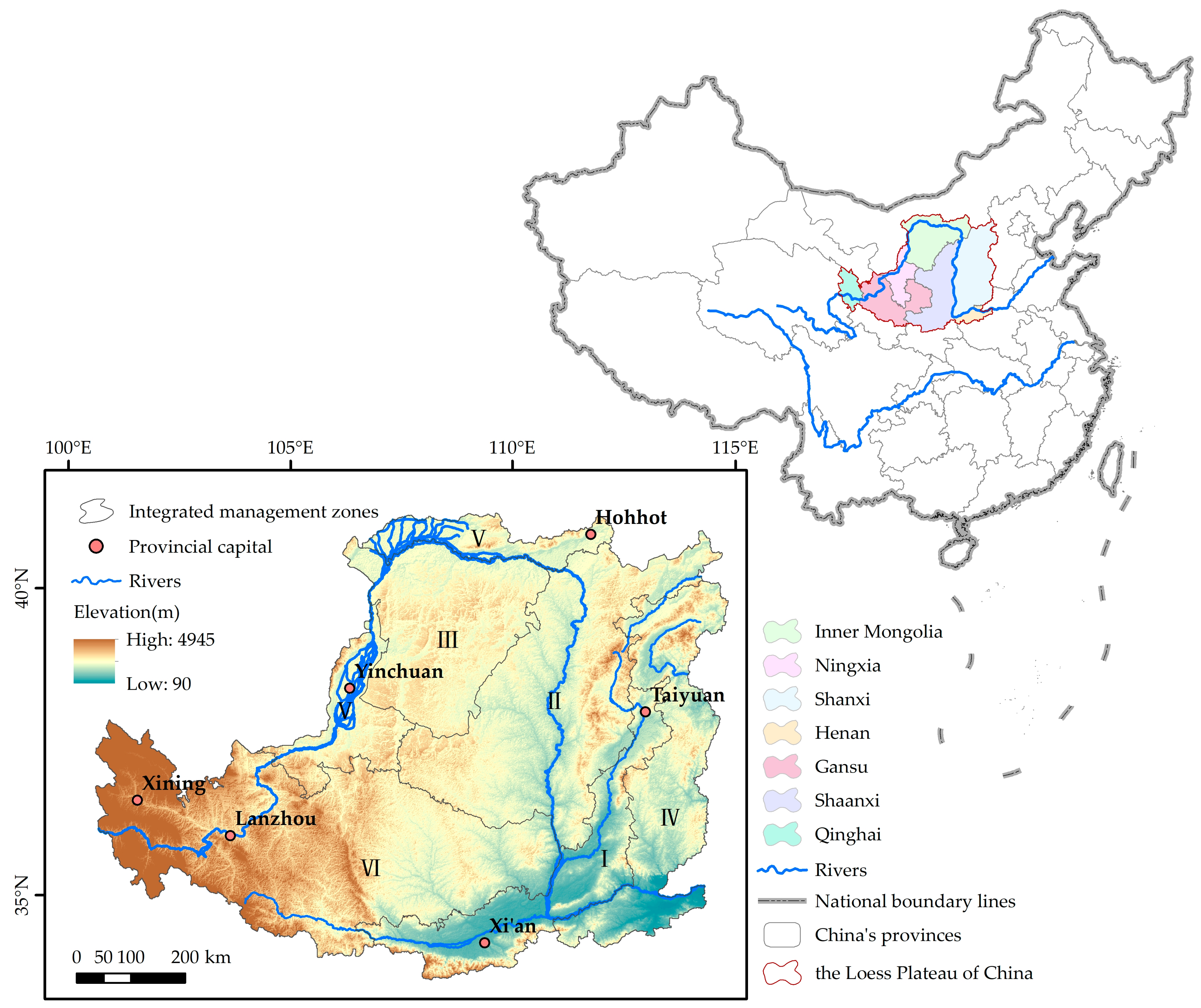
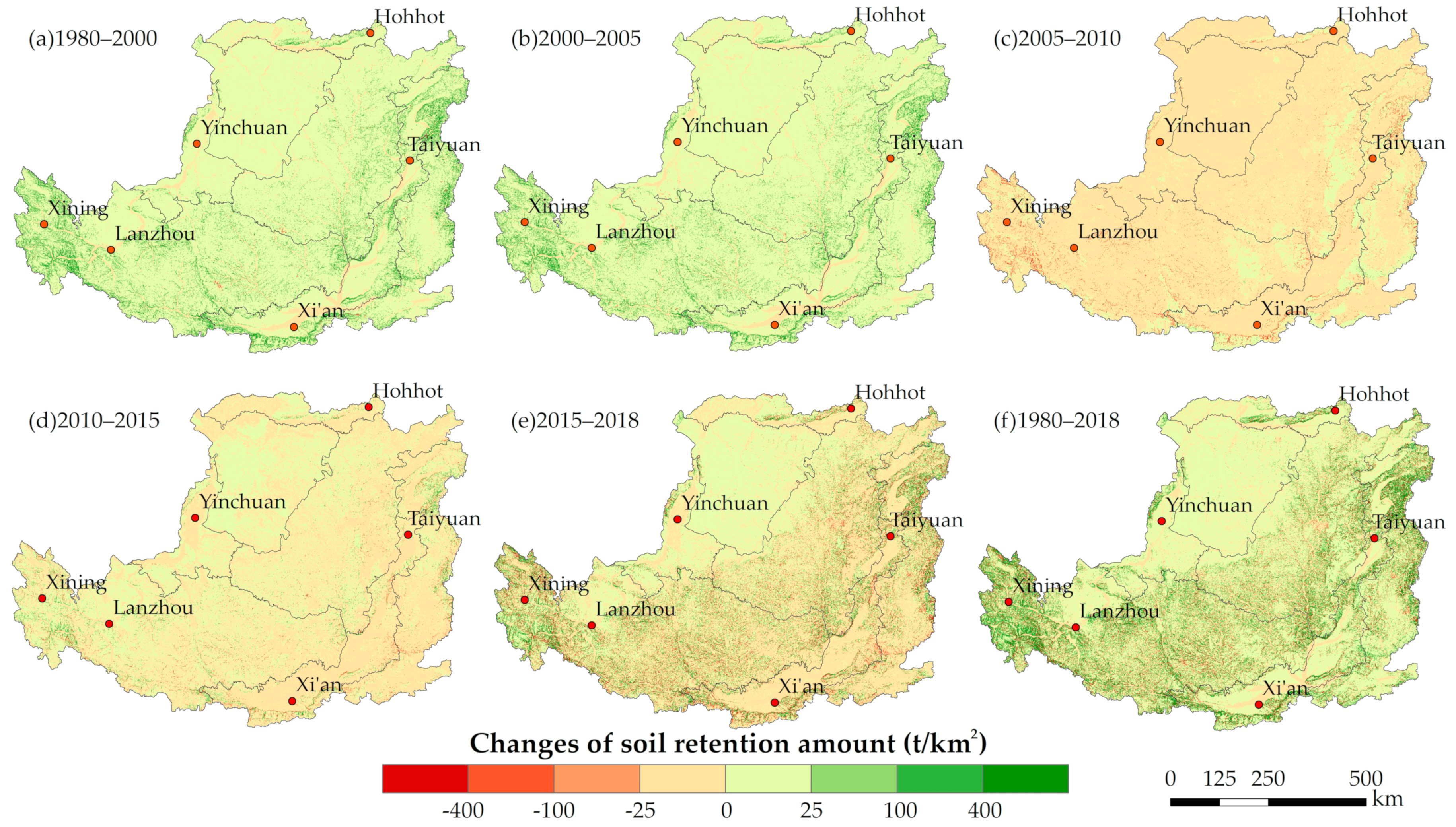

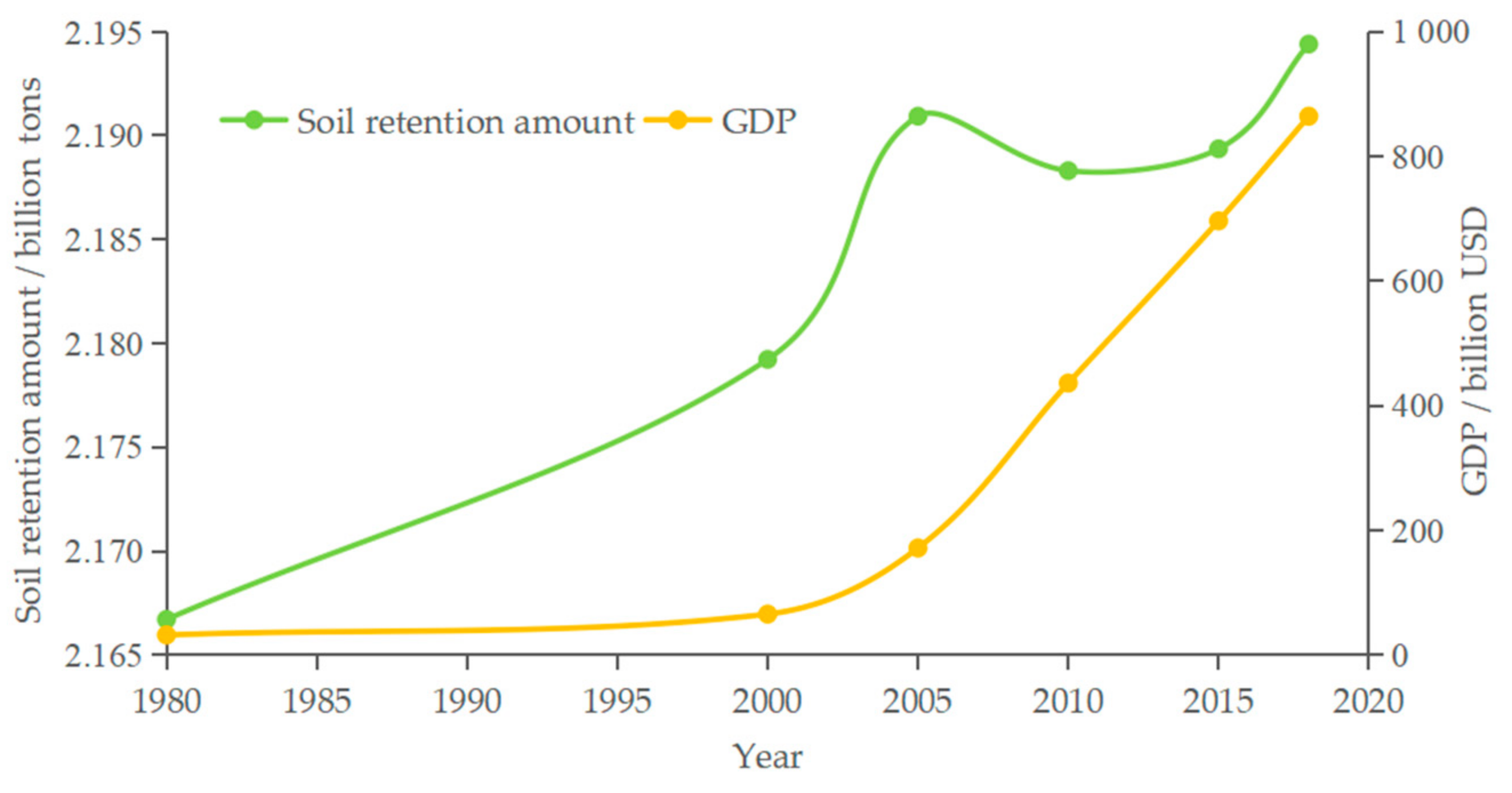

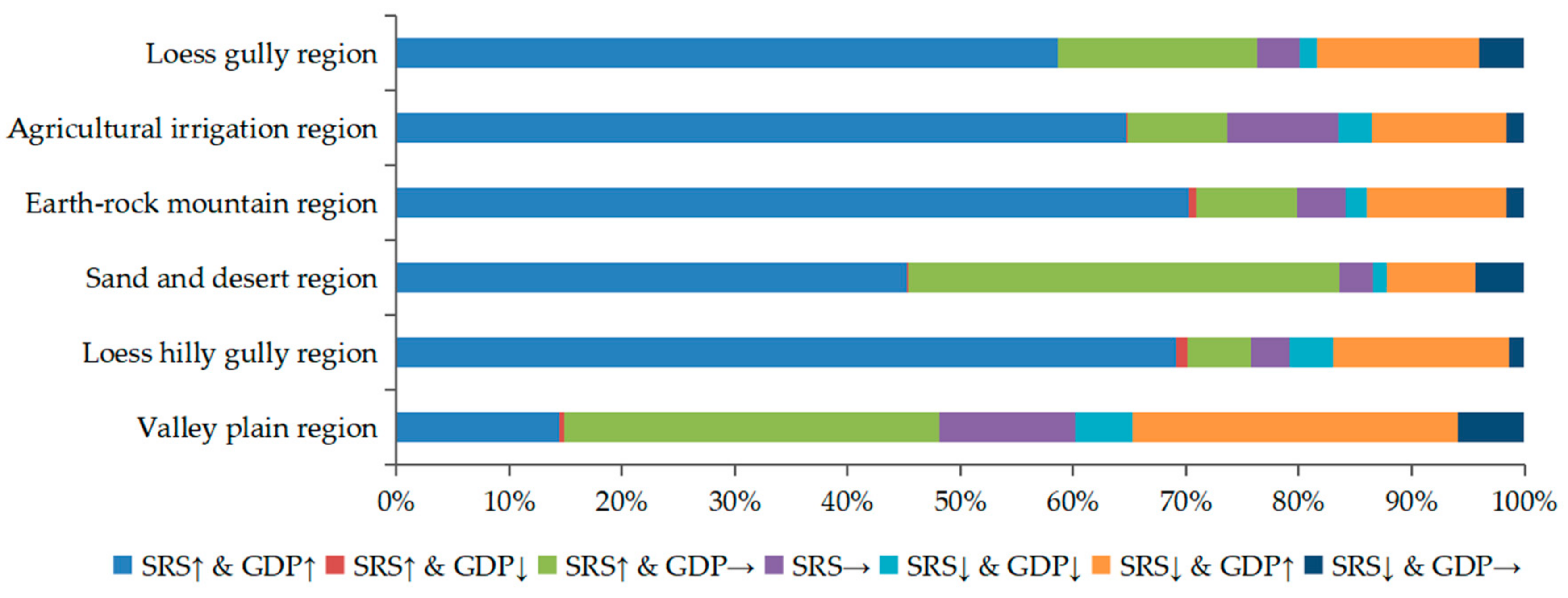

| Dataset Name | Dataset Description and Source |
|---|---|
| DEM | The 1 km DEM data were downloaded from the Resource and Environment Science and Data Center, Chinese Academy of Sciences (http://www.resdc.cn, accessed on 27 February 2021). |
| Rainfall erosivity index R | The 250 m R is the average value for 1986–2015. It was downloaded from the National Science and Technology Resources Sharing Service Platform–National Earth System Science Data Center–the Loess Plateau Subcenter (http://loess.geodata.cn, accessed on 2 March 2021). |
| Soil erodibility factor K | The 30 m K was calculated by achievements of the second national soil survey for 1979–1994, which was downloaded from the same data-sharing platform as the rainfall erosivity index R. |
| LULC | The 1 km LULC datasets include six land use types, including cultivated land, forest, grassland, water area, construction land, and unutilized land, covering the years 1980, 2000, 2010, 2015, and 2018 [49,50]. They were downloaded from the same data-sharing platform as DEM. |
| Watershed boundary | It was downloaded from the same data-sharing platform as the rainfall erosivity index R. |
| Cover-management factor C | The C of each land use type in corresponding years was calculated based on averaged Normalized Difference Vegetation Index (NDVI) of each land use type and the method of Cai et al. [51] (see Appendix A). The 1982–2020 monthly 5 km NDVI dataset product of China was used (http://loess.geodata.cn, accessed on 16 May 2023). |
| Support practice factor P | It was determined by the actual situation of the Loess Plateau [45]. |
| GDP | We collected the statistics of the GDP constant price from China’s city Statistical Yearbook and provincial Statistical Yearbook from 1980 to 2018, including the statistical yearbooks of Gansu, Ningxia, Inner Mongolia, Shaanxi, Shanxi, Henan, and Qinghai [52]. |
| Night-time light data | The 1992–2018 global night-time lighting dataset (https://doi.org/10.6084/m9.figshare.9828827.v2, accessed on 10 December 2021) [53] was used. It is a combination of the Defense Meteorological Satellite Program (DMSP)—Operational Linescan System (OLS) and the Visible Infrared Imaging Radiometer Suite (VIIRS) nightlight datasets by harmonizing the inter-calibrated night-time lighting observations from the DMSP data and the simulated DMSP-like night-time lighting observations from the VIIRS data. |
| Integrated Management Zone | 1980 | 2000 | 2005 | 2010 | 2015 | 2018 |
|---|---|---|---|---|---|---|
| Valley plain | 0.4237 | 0.4258 | 0.4276 | 0.4272 | 0.4272 | 0.4278 |
| Loess hilly gully | 0.3147 | 0.3164 | 0.3181 | 0.3177 | 0.3178 | 0.3183 |
| Sand and desert | 0.0057 | 0.0057 | 0.0058 | 0.0058 | 0.0058 | 0.0059 |
| Earth-rock mountain | 0.5452 | 0.5480 | 0.5506 | 0.5502 | 0.5504 | 0.5516 |
| Agricultural irrigation | 0.0446 | 0.0449 | 0.0452 | 0.0451 | 0.0452 | 0.0456 |
| Loess gully | 0.8329 | 0.8384 | 0.8437 | 0.8423 | 0.8429 | 0.8453 |
| Sum | 2.1667 | 2.1792 | 2.1909 | 2.1883 | 2.1894 | 2.1944 |
| Item | 1980 | 2000 | 2005 | 2010 | 2015 | 2018 |
|---|---|---|---|---|---|---|
| GDP statistics (unit: billion USD) | 88.10 | 159.87 | 361.74 | 851.73 | 1348.97 | 1576.05 |
| GDP analog value (unit: billion USD) | 88.32 | 161.19 | 323.25 | 758.40 | 1366.61 | 1549.70 |
| Relative error (ranged from 0 to 1) | 0.0025 | 0.0082 | 0.1064 | 0.1096 | 0.0131 | 0.0167 |
| Integrated Management Zone | 1980 | 2000 | 2005 | 2010 | 2015 | 2018 |
|---|---|---|---|---|---|---|
| Valley plain | 10.54 | 19.21 | 43.33 | 93.84 | 117.46 | 139.55 |
| Loess hilly gully | 6.42 | 12.89 | 37.77 | 91.95 | 158.90 | 207.83 |
| Sand and desert | 0.50 | 1.66 | 7.18 | 31.92 | 64.38 | 65.40 |
| Earth-rock mountain | 7.15 | 13.54 | 33.53 | 78.23 | 110.13 | 130.70 |
| Agricultural irrigation | 3.66 | 8.81 | 23.16 | 64.97 | 95.84 | 101.31 |
| Loess gully | 3.97 | 9.61 | 26.81 | 75.41 | 149.72 | 219.47 |
| Sum | 32.24 | 65.72 | 171.78 | 436.32 | 696.44 | 864.27 |
Disclaimer/Publisher’s Note: The statements, opinions and data contained in all publications are solely those of the individual author(s) and contributor(s) and not of MDPI and/or the editor(s). MDPI and/or the editor(s) disclaim responsibility for any injury to people or property resulting from any ideas, methods, instructions or products referred to in the content. |
© 2023 by the authors. Licensee MDPI, Basel, Switzerland. This article is an open access article distributed under the terms and conditions of the Creative Commons Attribution (CC BY) license (https://creativecommons.org/licenses/by/4.0/).
Share and Cite
Li, S.; Xie, J.; Paudel, B. Do Ecological Restoration Projects Undermine Economic Performance? A Spatially Explicit Empirical Study in Loess Plateau, China. Remote Sens. 2023, 15, 3035. https://doi.org/10.3390/rs15123035
Li S, Xie J, Paudel B. Do Ecological Restoration Projects Undermine Economic Performance? A Spatially Explicit Empirical Study in Loess Plateau, China. Remote Sensing. 2023; 15(12):3035. https://doi.org/10.3390/rs15123035
Chicago/Turabian StyleLi, Shicheng, Jinqian Xie, and Basanta Paudel. 2023. "Do Ecological Restoration Projects Undermine Economic Performance? A Spatially Explicit Empirical Study in Loess Plateau, China" Remote Sensing 15, no. 12: 3035. https://doi.org/10.3390/rs15123035
APA StyleLi, S., Xie, J., & Paudel, B. (2023). Do Ecological Restoration Projects Undermine Economic Performance? A Spatially Explicit Empirical Study in Loess Plateau, China. Remote Sensing, 15(12), 3035. https://doi.org/10.3390/rs15123035









